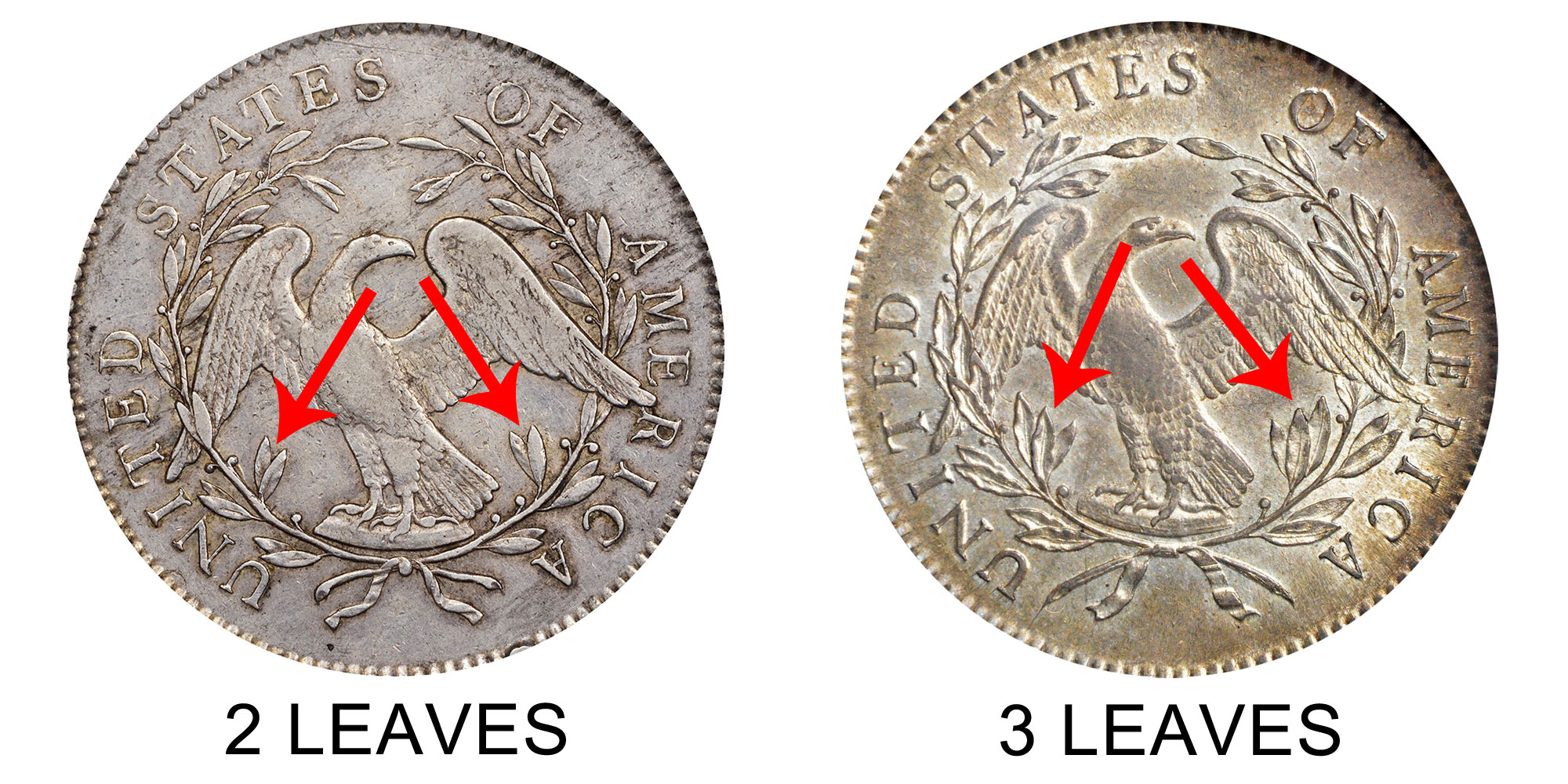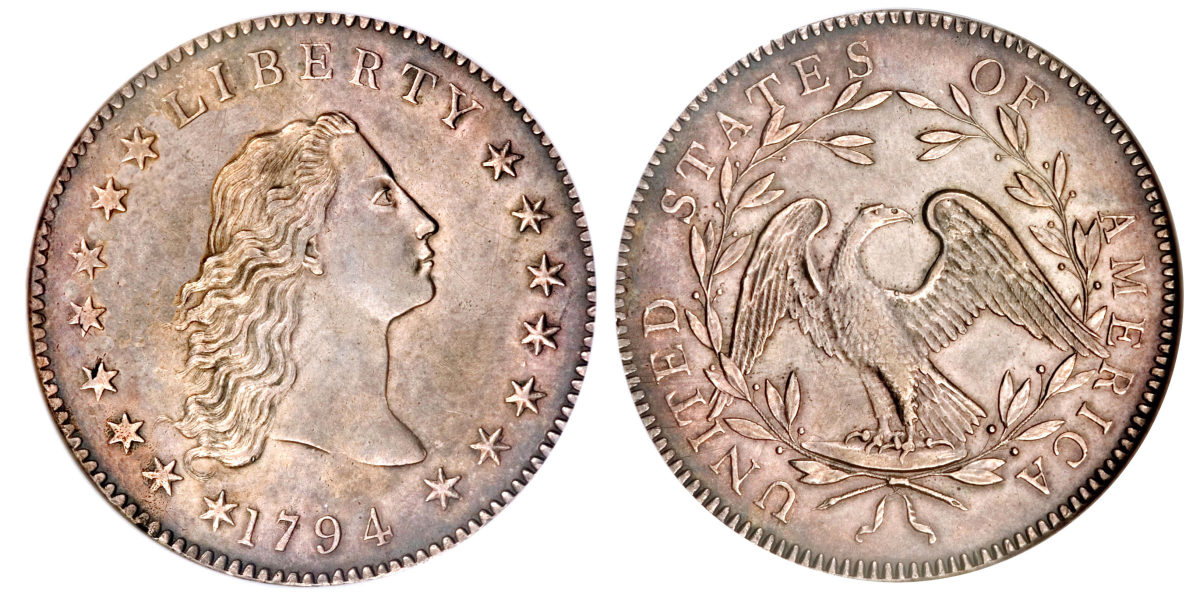1795 Silver Dollar
1795 Silver Dollar Value
The Flowing Hair Dollar represents the very first silver dollar and the largest silver denomination minted in the United States. The coins were produced for just two years from 1794 to 1795 at the Philadelphia Mint. The 1794 is a famous rarity and one of the keys to a complete set of silver dollars, while the 1795 relatively more available. The 1795 Flowing Hair silver dollar is a scarce coin in the absolute sense but far more common than its 1794 dollar counterpart. For this reason, type set collectors who desire a Flowing Hair dollar will tend to focus on buying a 1795 issue because it is the more affordable option in most cases.
Flowing Hair Dollars - Scot’s Flowing Hair Silver Dollar 1794-1795. Chief Engraver Robert Scot designed the Flowing Hair Silver Dollar. It was issued from 1794 to 1795. It showed a portrait of Liberty facing right with her hair loosely tied behind her head. This feature evolved from the Flowing Hair Liberty portrait that was featured on Joseph Wright’s Libertas Americans Medal of 1783. Over time Liberty was turned to the right and was shown without the liberty pole and cap. However, the basic idea of Liberty’s hair free flowing is similar to the earlier concept. Above her head is the word LIBERTY, and the date is below. There are fifteen stars in accord with the number of states that made up the Union in 1794, eight to the left and seven to the right. The reverse, which is similar to the Flowing Hair Half Dime and Half Dollar, shows a perched eagle with wings spread looking to the right.

- The Draped Bust dollar is a United States dollar coin minted from 1795 to 1803, and was reproduced, dated 1804, into the 1850s. The design succeeded the Flowing Hair dollar, which began mintage in 1794 and was the first silver dollar struck by the United States Mint.
- Coinage of the silver dollar was suspended after 1904, when demand was low and the bullion supply became exhausted. Under provisions of the Pittman Act of 1918, 270,232,722 silver dollars were melted, and later, in 1921, coinage of the silver dollar was resumed.
1795 Silver Dollar Weight
A wreath tied with a bow encircles the eagle. The legend UNITED STATES OF AMERICA is in an arc around the eagle. Except for its edge lettering, the coin has no denomination-- something that might appear as a sign of ineptitude on the part of early Mint employees to someone familiar with United States coinage of the 21st century. The omission was intentional, however, as United States coinage was new to the world market of the 18th century and the term “Dollar” would have been unfamiliar to merchants of the day. Like European coinage of the time, silver and gold pieces were valued by their weight and fineness so the denomination was largely irrelevant. Prior to the issuance of silver coinage, only copper coins were made because neither the Chief Coiner, Henry Voigt, nor the Assayer, Albion Cox, could post the $10,000 bond required to be responsible for gold and silver. Thomas Jefferson recommended to President Washington that this bond requirement be reduced. Washington agreed, and in 1794 Scot was able to produce a die for the cent, half dollar, and the dollar coins. Since there was no standardized hubbing, individual punches were used for numbers, letters, the stars, and leaf punches. The edge was lettered HUNDRED CENTS ONE DOLLAR OR UNIT with decorative designs in between the words.

It is estimated that about 140 to 150 examples of the 1794 Flowing Hair Silver Dollar survive out of the 1,758 dollars that were struck on a hand-turned screw press at the Mint in Philadelphia. The only day of production for dollar coins that year was October 15th. They were made from silver provided by David Rittenhouse, the Mint Director, who wanted production to begin as soon as possible. The early United States Mint was dependent on private deposits of precious metals. Rittenhouse deposited $2,001.34 worth of silver on August 29, 1794 so that silver dollar striking could begin. Using Rittenhouse’s bullion and one set of dies, 2,000 silver dollars were struck. Of these, 242 were found unacceptable and were either remelted or used as planchets for the next year’s run. All 1,758 dollars were delivered to Rittenhouse on October 15th, and it was his responsibility to distribute the coins since he had deposited the bullion.
Even those 1794 and 1795 Flowing Hair dollars that were acceptable for distribution show many of the difficulties the early United States Mint had with coinage operations. Virtually all of the known examples are softly struck to one degree or another at the left-obverse and reverse border. This is due to the Mint’s use of a press that was intended for smaller-size coins, as well as the fact that the dies eventually “slipped” and became misaligned in the press. Additionally, many 1794 and 1795 Flowing Hair dollars display adjustment marks that represent the Mint’s filing down of overweight planchets to make them confirm to the legally specified weight range for this issue. While these adjustment marks are often innocuous, as on the present coin, they are sometimes so numerous as to severely compromise one or more elements of a coin’s design.

1795 Silver Dollars
Coin Collectors have pursued the 1794 silver dollar from the earliest days of the hobby. It is the most important and one of the rarest silver dollars. An example of this date was featured in the first all coin auction sale held in this country, the Roper Sale (M. Thomas and Sons, February, 1851), lot 22, item number 4. The charisma of this coin cannot be overemphasized. Many collectors choose this date over the much less expensive 1795 dollar when putting together a type set. Of course its position as first-date-of –issue is but another reason for advanced collectors to obtain this date. Regardless of striking quality or level of preservation, a 1794 Flowing Hair Silver Dollar is extremely important in numismatic circles, and the ownership of even a low-grade and/or impaired example is the mark of an important collection. Somewhat more common are the Flowing Hair Dollars of 1795 with the original mintage of 160,295. Varieties include Two Leaves, Three Leaves, and the Silver Plug.
1795 Silver Dollar Counterfeit

1795 Silver Dollar Draped Bust Value
Before the Revolutionary War, coins from many European nations circulated freely in the American colonies along with decimal coinage issued by the various colonies. Chief among these was the Spanish silver dollar coins (also called pieces of eight or eight reales) minted in Mexico and other colonies with silver mined from Central and South American mines. These coins, along with others of similar size and value, were in use throughout the colonies. They remained legal tender in the United States until 1857. The dollar was intended to replace the Spanish, English, Dutch and French coins that dominated the commerce of the Confederation era. It was authorized on April 2, 1792 in an act that also created the United States Mint and our nation’s coinage. Because it was the Unit, the silver dollar was the most important coin created and the basis of the nation’s monetary system. All other coins struck, and all paper money as well, are either fractional parts or multiples of the dollar, and the Flowing Hair Silver dollar was the first one made.